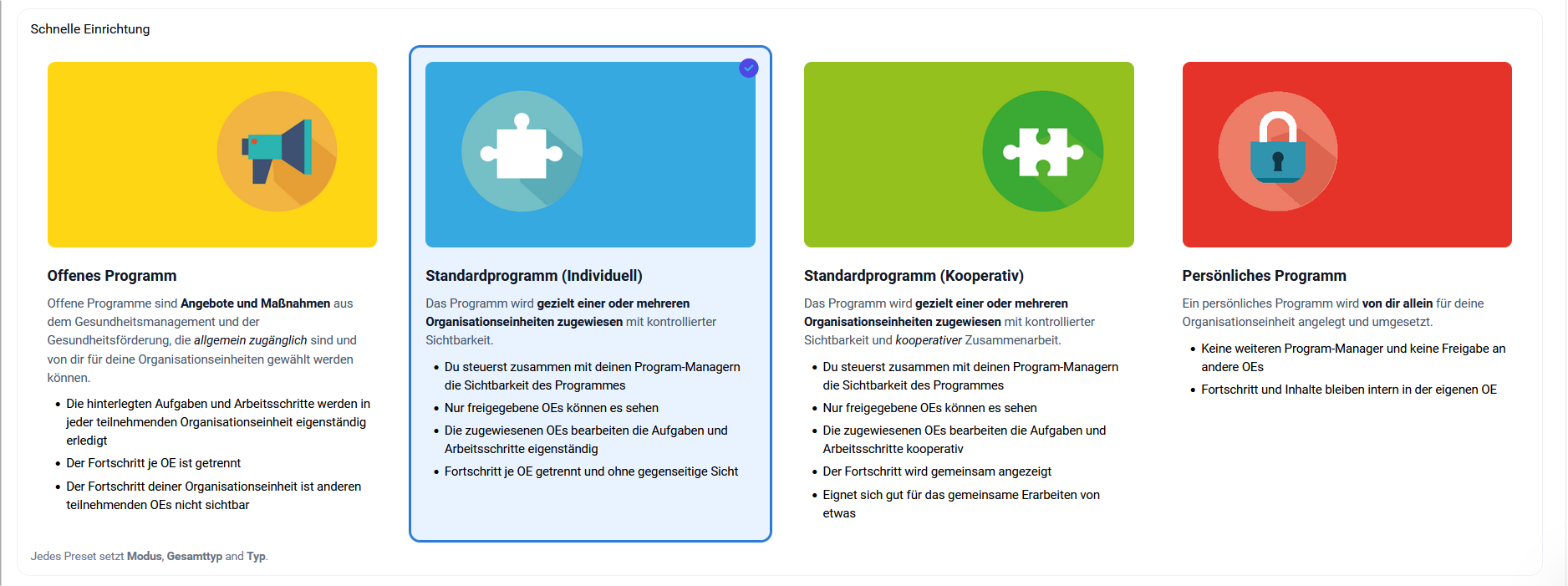Visibility: Cooperative, Individual, and Own Programs
The visibility settings determine who can access your programs and checklists and in what form collaboration takes place. The system distinguishes between different visibility levels, each optimized for different use cases.
Cooperative programs enable collaboration between different organizational units, individual programs are limited to specific persons or teams, and own programs remain in your personal area. The right choice of visibility setting is crucial for the success of your programs and the efficiency of collaboration.
The Three Visibility Levels

The system offers you three predefined visibility levels that are optimized for different forms of collaboration:
1. Cooperative Programs (Team & Collaboration)
For organization-wide collaboration:
- Visibility: All participating organizational units see the program
- Transparency: Form entries and progress are visible to all participants
- Communication: Open exchange between all involved parties via the Inbox
- Coordination: Program Managers coordinate the overarching collaboration
Ideal for:
- Strategic initiatives with multiple departments
- Organization-wide change processes
- Projects with high coordination needs
- Measures that require transparency between teams
2. Individual Programs (Standard)
For focused teamwork:
- Visibility: Only assigned persons and teams see the program
- Data Protection: Form entries are only visible to program managers and the respective organizational unit
- Control: Limited number of participants for efficient management
- Flexibility: Customizable permissions as needed
Open Programs: Individual programs can be made available as "open programs" in the Library. These remain individual (not cooperative) in their functionality, but are available to other organizational units as templates.
Ideal for:
- Department-specific projects
- Confidential measures
- Pilot projects with limited participant groups
- Programs with sensitive data
- Proven templates for other teams (as open programs)
3. Own Programs (Personal)
For personal work organization:
- Visibility: Only visible to you and program managers you designate
- Privacy: Complete control over access and content
- Self-responsibility: Independent processing and documentation
- Efficiency: No external coordination required
Ideal for:
- Personal development plans
- Individual work assignments
- Self-organization and control
- Preparatory work for larger programs
Visibility Settings in Detail
Data Visibility and Privacy
| Visibility Level | Program Access | Form Entries | Progress | Communication | Library |
|---|---|---|---|---|---|
| Cooperative | All participants | Visible to all | Transparent | Open | - |
| Individual | Assigned teams | Only for own unit + PM | Limited | Controlled | Can be provided as "open" |
| Own | Only you + PM | Only for you + PM | Private | Direct | - |
Permissions and Roles
Program managers have in all visibility levels:
- Full access to all program components
- Insight into all form entries and progress
- Authorization to communicate with all participants
- Ability to adjust tasks and structures
Participants see depending on visibility level:
- Cooperative: All activities of all participants
- Individual: Only own activities + overall progress
- Own: Only own activities
Changing Visibility
Program managers can adjust visibility settings even after program creation. Note that changing from "cooperative" to "individual" restricts transparency, while changing from "individual" to "cooperative" makes all data visible to all participants.
The assignment of organizational units is not only organizationally but also legally relevant for audit and compliance purposes. Changes should therefore be carefully planned and documented.